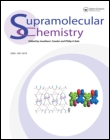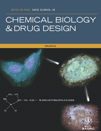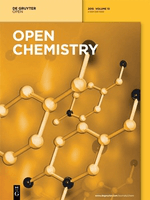
SUPRAMOLECULAR CHEMISTRY
Scope & Guideline
Fostering Collaboration in Supramolecular Research
Introduction
Aims and Scopes
- Supramolecular Assembly and Functionality:
Research on the principles and methodologies for constructing supramolecular assemblies, emphasizing the underlying non-covalent interactions that govern their formation and stability. - Chemical Sensing and Detection:
Development of novel supramolecular sensors and probes for detecting chemical species, including ions, small molecules, and biomolecules, highlighting advances in selectivity and sensitivity. - Applications in Drug Delivery and Biomedicine:
Exploration of supramolecular systems as carriers for drug delivery, focusing on their ability to enhance therapeutic efficacy and targeting capabilities. - Theoretical and Computational Studies:
Utilization of theoretical models and computational methods to understand and predict the behavior of supramolecular systems, aiding in the design of new materials. - Materials Science and Nanotechnology:
Investigation of supramolecular materials for various applications, including photonic, electronic, and catalytic processes, emphasizing their structural and functional properties.
Trending and Emerging
- Bioinspired and Biomimetic Supramolecular Systems:
An increasing number of studies focus on bioinspired designs, utilizing principles from nature to develop supramolecular systems that mimic biological functions, which is crucial for advancements in drug delivery and material science. - Machine Learning and Computational Approaches:
The integration of machine learning techniques in supramolecular chemistry is emerging, with researchers utilizing these tools to predict molecular interactions and optimize supramolecular designs. - Environmental Applications:
There is a growing emphasis on the development of supramolecular systems for environmental applications, particularly in sensing and remediation of pollutants, reflecting an increasing concern for sustainability and environmental health. - Chiral Supramolecular Chemistry:
Research focusing on chiral supramolecular assemblies is becoming more prominent, driven by the importance of chirality in pharmaceuticals and materials science. - Smart Materials and Responsive Systems:
Emerging trends in the design of smart materials that respond to external stimuli (e.g., pH, light, temperature) are being explored, suggesting a shift towards more dynamic and functional supramolecular systems.
Declining or Waning
- Traditional Organic Synthesis:
There has been a noticeable decrease in publications focused solely on classical organic synthesis methods without supramolecular context, as the field increasingly emphasizes the integration of supramolecular chemistry with other disciplines. - Inorganic Supramolecular Systems:
Research on purely inorganic supramolecular systems appears to be waning, as the journal's focus shifts more towards organic and hybrid systems that demonstrate significant functional properties. - Historical Reviews and Commentary:
The frequency of publications that serve as historical overviews or commentaries on supramolecular chemistry has declined, suggesting a preference for original research articles that present new findings and advancements.
Similar Journals

JOURNAL OF CHEMICAL CRYSTALLOGRAPHY
Transforming research into understanding the essence of materials.Welcome to the Journal of Chemical Crystallography, a prominent publication dedicated to the advancement of knowledge in the fields of chemical crystallography, general chemistry, and condensed matter physics. Published by Springer/Plenum Publishers, this journal provides a critical platform for researchers, professionals, and students to disseminate and access innovative research findings and methodologies from 1994 to 2024. With an ISSN of 1074-1542 and E-ISSN 1572-8854, the journal currently holds a Q4 quartile ranking in both Chemistry and Condensed Matter Physics, reflecting its broadening scope and niche significance within the scientific community. While it operates under a traditional access model, it endeavors to promote high-quality research that advances theoretical and practical aspects of crystallography, making it an essential resource for those involved in these dynamic disciplines. Join us as we explore the intricate world of chemical structures and their properties, bridging gaps between chemistry and physics.

University Politehnica of Bucharest Scientific Bulletin Series B-Chemistry and Materials Science
Innovating Research, Bridging Theory and ApplicationUniversity Politehnica of Bucharest Scientific Bulletin Series B-Chemistry and Materials Science is a renowned academic journal published by POLYTECHNIC UNIV BUCHAREST, situated in Romania. With the ISSN 1454-2331, this journal serves as a dynamic platform for the dissemination of innovative research findings in the fields of chemistry and materials science. Although classified in the Q4 quartile of both Chemistry (miscellaneous) and Materials Science (miscellaneous) categories for 2023, it has made a significant impact by providing a venue for emerging scholars and established researchers alike to share their work. The journal seeks to bridge theoretical insights and practical applications, promoting interdisciplinary dialogue and advancing scientific understanding. The scope encompasses a broad range of topics, reflecting contemporary advancements and challenges within the field. To facilitate access to its articles, while it does not currently operate under an open-access model, the journal remains committed to enhancing visibility through digital libraries. With a publication history spanning from 1999 to 2024, the journal is vital for all stakeholders—researchers, professionals, and students—seeking to stay abreast of developments in chemistry and materials science.

Chemical Biology & Drug Design
Advancing drug discovery through innovative chemical insights.Chemical Biology & Drug Design, an esteemed publication by WILEY, serves as a vital platform for the dissemination of pioneering research in the interdisciplinary fields of biochemistry, drug discovery, molecular medicine, organic chemistry, and pharmacology. With a dedicated commitment to advancing the understanding of chemical interactions and drug development, this journal not only fosters innovation but also bridges the gap between theoretical research and practical applications. It boasts an impressive impact factor and is recognized in the 2023 category quartiles as Q3 in Biochemistry and Molecular Medicine, and Q2 in Drug Discovery, Organic Chemistry, and Pharmacology, indicating its relevance and influence in these crucial areas. The journal’s rankings across various Scopus categories further solidify its position as a reputable resource for researchers, professionals, and students striving to stay at the forefront of medicinal chemistry and drug design. While primarily traditional access-based, the journal's evolving scope from 2006 to 2024 ensures an ongoing contribution to essential scientific dialogue, making it an indispensable read for those committed to advancing health sciences.

JOURNAL OF STRUCTURAL CHEMISTRY
Advancing Knowledge in Inorganic and Materials ChemistryThe JOURNAL OF STRUCTURAL CHEMISTRY, published by PLEIADES PUBLISHING INC, is a premier resource in the fields of Inorganic Chemistry, Materials Chemistry, and Physical and Theoretical Chemistry. Established in 1960, this journal has been providing a platform for groundbreaking research, facilitating the advancement of knowledge and innovation up to the year 2024. With an ISSN of 0022-4766 and an E-ISSN of 1573-8779, this journal strives to maintain high academic standards, as evidenced by its quartile rankings in 2023, where it ranks Q4 across various chemistry categories. While it currently does not offer open access, the journal's insightful articles are crucial for professionals and students seeking to enhance their understanding and expertise in structural chemistry. Subscribers can expect a comprehensive collection of peer-reviewed research, empirical findings, and theoretical discussions that contribute significantly to the scientific community. With its strong historical foundation and ongoing commitment to quality, the JOURNAL OF STRUCTURAL CHEMISTRY continues to be an essential resource for those passionate about the complexities of structural chemistry.

Aggregate
Connecting global minds in molecular biology.Aggregate, published by WILEY, is a premier open-access journal established in 2020, dedicated to advancing the fields of Chemistry, Materials Chemistry, Materials Science, and Molecular Biology. Based in the United States, this rapidly rising journal (Q1 in various categories as of 2023) has quickly made its mark as a valuable resource, evidenced by its impressive Scopus rankings—ranking #6 in Chemistry (miscellaneous) and #13 in Materials Science (miscellaneous) among others—place it firmly in the top percentiles of these disciplines. With an emphasis on rigorous peer-reviewed research, Aggregate provides an essential platform for researchers to disseminate groundbreaking findings and innovative methodologies that propel the scientific community forward. As an open-access journal, it ensures that cutting-edge research is accessible to a global audience, thereby enriching the dialogue among professionals, researchers, and students alike. Explore the latest advancements and contribute to the vibrant discourse in these critical areas of science by publishing with Aggregate.

MONATSHEFTE FUR CHEMIE
Advancing Knowledge in the Heart of Chemical SciencesMONATSHEFTE FUR CHEMIE, an esteemed journal published by Springer Wien, has been a significant contributor to the field of chemistry since its inception in the late 19th century. With a rich history spanning from 1880 to the present, this journal provides a platform for innovative research and comprehensive reviews in various areas of general chemistry. Although it currently holds a Q3 ranking in the miscellaneous category of chemistry, its commitment to maintaining high academic standards is reflected in its continued relevance and citation impact, as evidenced by its Scopus ranking. Researchers, professionals, and students engaged in chemical sciences will find this journal a valuable resource for advancing their knowledge and contributing to ongoing discussions in the field. For those looking to stay updated on the latest developments in chemistry while engaging with a storied publication, MONATSHEFTE FUR CHEMIE is a pivotal source of insightful content.

JOURNAL OF POLYMER SCIENCE
Leading the Charge in Polymer Research and DevelopmentJOURNAL OF POLYMER SCIENCE, published by WILEY, is a premier, open-access journal dedicated to advancing the field of polymer science and its applications. With an ISSN of 2642-4150, it offers a platform for high-quality research and innovative ideas, contributing significantly to the understanding of polymaterials and their functionalities. The journal is recognized for its exceptional impact within various categories, consistently achieving Q1 rankings in Materials Chemistry, Physical and Theoretical Chemistry, and Polymers and Plastics, demonstrating its influential presence in the academic community. As of 2023, it holds a distinguished position in Scopus rankings, underscoring its relevance and rigorous peer-review process. By facilitating open access to vital research findings, the JOURNAL OF POLYMER SCIENCE plays a crucial role in fostering collaboration and knowledge transfer among researchers, professionals, and students, paving the way for innovative developments in polymer applications and materials science.

Open Chemistry
Empowering the Global Chemistry Community Through Open ResearchOpen Chemistry, published by DE GRUYTER POLAND SP Z O O, is a distinguished peer-reviewed journal that has been serving the global chemistry community since its inception. With an ISSN of 2391-5420 and an E-ISSN also of 2391-5420, this open-access journal has been accessible to researchers and practitioners alike since 2015, ensuring a wide dissemination of high-quality research findings. Located in Germany, specifically at BOGUMILA ZUGA 32A STR, 01-811 WARSAW, MAZOVIA, POLAND, Open Chemistry aims to publish innovative research across various chemical disciplines, with special attention to miscellaneous chemistry and materials chemistry. It is currently ranked in the Q3 category for both fields as of 2023, reflecting its solid standing within the academic community, with specific ranks of 187/408 in General Chemistry and 153/317 in Materials Chemistry, corresponding to respective percentiles of 54 and 51. Open Chemistry not only enhances the accessibility of cutting-edge research but also serves as a vital resource for students, professionals, and scholars seeking to advance their knowledge in the rapidly evolving landscape of chemical sciences.

Wiley Interdisciplinary Reviews-Computational Molecular Science
Pioneering Research at the Forefront of Molecular ScienceWiley Interdisciplinary Reviews: Computational Molecular Science is a premier journal published by WILEY, dedicated to the intersection of computational techniques and molecular science. Boasting an impressive impact factor and consistently ranking in the Q1 category across several key disciplines including Biochemistry, Computational Mathematics, Computer Science Applications, Materials Chemistry, and Physical and Theoretical Chemistry, this journal plays a crucial role in disseminating high-quality research that bridges multiple fields. With its focus on providing a platform for interdisciplinary dialogue and innovative computational solutions, it serves as an essential resource for researchers, professionals, and students eager to push the boundaries of molecular science. While the journal does not currently offer open access, it remains a vital conduit for scholarly communication, fostering advancements in understanding molecular interactions through computational methods. The journal is based in the United States, contributing to its global outreach and impact in the scientific community.

ANGEWANDTE CHEMIE-INTERNATIONAL EDITION
Advancing Chemistry Through Rigorous ResearchANGEWANDTE CHEMIE-INTERNATIONAL EDITION, published by WILEY-V C H VERLAG GMBH, stands as a leading journal in the fields of Chemistry and Catalysis, holding a prestigious position with a Q1 ranking in both categories as of 2023. With an ISSN of 1433-7851 and an E-ISSN of 1521-3773, this esteemed publication has been an invaluable resource for the global scientific community since its inception in 1962. The journal's impact is further underscored by its remarkable Scopus rankings, where it occupies the 13th place among 408 journals in General Chemistry and the 4th place among 68 in Chemical Engineering - Catalysis, marking it in the 96th and 94th percentiles, respectively. Although it does not offer Open Access, ANEWANDTE CHEMIE-INTERNATIONAL EDITION remains essential for researchers, professionals, and students seeking to stay abreast of cutting-edge developments and innovations in chemical sciences. Its comprehensive scope and rigorous peer-review process ensure that only the highest quality research finds its way to publication, contributing significantly to the advancement of chemistry worldwide.